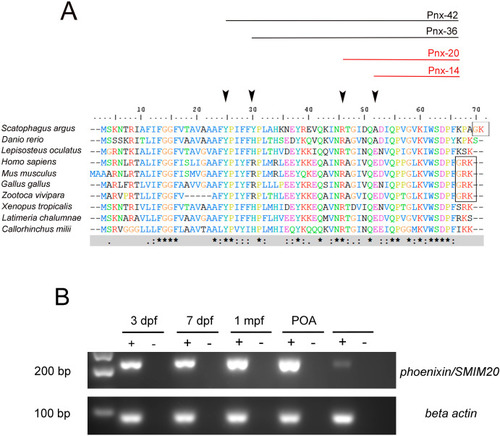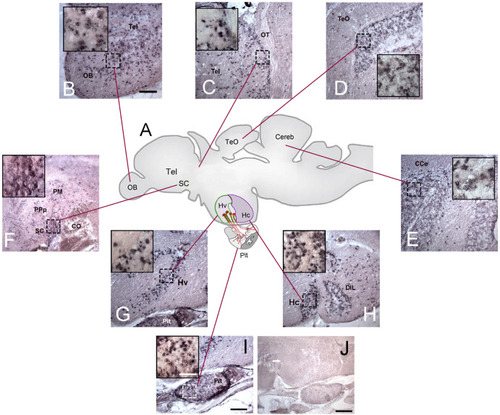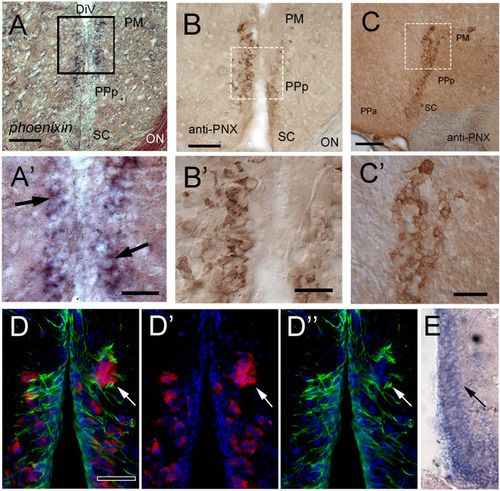- Title
-
phoenixin(smim20), a gene coding for a novel reproductive ligand, is expressed in the brain of adult zebrafish
- Authors
- Ceriani, R., Calfún, C., Whitlock, K.E.
- Source
- Full text @ Gene Expr. Patterns
|
Characterization of zebrafish phoenixin/smim20. (A) Amino acid sequence alignment of Phoenixin in spotted scat, (Scatophagus argus), spotted gar, (Lepisosteus oculatus), humans (Homo sapiens), mouse (Mus musculus), chicken, (Gallus gallus) common lizard, (Zootoca vivipara), western clawed frog, (Xenopus tropicalis), Coelacanth, (Latimeria chalumnae) and elephant shark, (Callorhinchus milii). Homo sapiens, Mus musculus, Gallus gallus, Zootoca vivipara and Scatophagus argus contain amidation sites (rectangles). Within the PNX amino acid sequence cleavage sites are indicated (arrowheads) and predicted (black) and confirmed (red) peptides of varying lengths are indicated (top) (Yosten et al., 2013). (B) phoenixin/smim20 is expressed in embryos and juvenile zebrafish. RT-PCR from cDNA samples of 3 dpf, 7dpf, 1mpf and of the pre-optic area (POA) of adult fish. +, -: genomic DNA from POA of adult zebrafish. Housekeeping gene: beta actin. EXPRESSION / LABELING:
|
|
phoenixin/smim20 is expressed in the brain of adult zebrafish. (A) Diagram of sagittal section of generalized adult fish brain, anterior to the left, the location of GnRH cells (red; in fishes with GnRH cells). (B–J) In situ hybridization using phoenixin/smim20 probe, 20 μm sagittal cryosections, anterior to the left. Insets show higher magnification of cells expressing phoenixin/smim20. phoenixin/smim20 is expressed distinct brain regions outside the hypothalamic-pituitary axis including (B) olfactory bulb (OB), (C) telencephalon (Tel), (D) tectum opticum (TeO), and (E) the corpus cerebelli (CCe) of the cerebellum. Within the preoptic area (F) expression was observed in the magnocellular pre-optic nucleus (PM), posterior parvocellular pre-optic nucleus (PPp), suprachiasmatic nucleus (SC) and chiasma opticum (CO). Strong hypothalamic expression of phoenixin/smim20 was observed in (G) the ventral zone of the periventricular hypothalamus (Hv), and (H) the caudal zone of periventricular hypothalamus (Hc) and dorsal zones of periventricular hypothalamus, (DIL). Expression was also observed in the pituitary (I). phoenixin/smim20 sense probe (J) shows no labeling. Scale bars: (B–I) 100 μm; (J) = 50 μm; boxed areas = 20 μm. High magnification views are shown in boxed areas. (A modified from Whitlock et al., 2019). EXPRESSION / LABELING:
|
|
Expression of phoenixin/smim20 and of PNX-like immunoreactivity in the adult hypothalamus. (A, A′, B, B′: transverse cryosection) (A, A′) phoenixin/smim20 is expressed in the magnocellular nucleus (PM) of the POA; (A′) Higher magnification of boxed area in A. (B) PNX-like immunoreactivity in cells distributed adjacent to the diencephalic ventricle (DiV) and in the magnocellular pre-optic nucleus (PM) and parvocellular pre-optic nucleus (PPp). (B′) Higher magnification of boxed area in B. (C, C′) Sagittal sections, anterior to the left, labeled with anti-PNX antibody. (C) Immunolabeling of cells in the POA. (C′) Higher magnification view of area boxed in C. (D-D″) Transverse cryosections showing fluorescently labeled PNX-like immunoreactivity (red, D, D′) and ant-Zrf1 (green, D, D″) in the posterior parvocellular preoptic nucleus PPp (see Fig. 2F). (E) In situ hybridization showing phoenixin/smim20 expression in the same region (arrow D-D″, E; transverse cryosection). Abbreviations: PM: magnocellular pre-optic nucleus; PPp: parvocellular pre-optic nucleus, posterior part; SC: suprachiasmatic nucleus, ON optic nerve. A-E. All images are from 20 μm cryostat cross-sections of adult brain. Scale bars: A, B, C = 50 μm; A′, B′, C’ = 25 μm. D-D″, E = 30 μm. EXPRESSION / LABELING:
|
Reprinted from Gene expression patterns : GEP, 39, Ceriani, R., Calfún, C., Whitlock, K.E., phoenixin(smim20), a gene coding for a novel reproductive ligand, is expressed in the brain of adult zebrafish, 119164, Copyright (2020) with permission from Elsevier. Full text @ Gene Expr. Patterns



